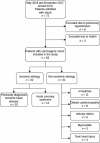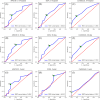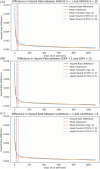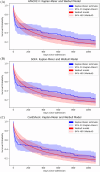Value of APACHE II, SOFA and CardShock scoring as predictive tools for cardiogenic shock: A single-centre pilot study
- PMID: 39136422
- PMCID: PMC11631277
- DOI: 10.1002/ehf2.15020
Value of APACHE II, SOFA and CardShock scoring as predictive tools for cardiogenic shock: A single-centre pilot study
Abstract
Aims: The aim of this study was to determine the value of the Acute Physiology and Chronic Health Evaluation II (APACHE II), Sequential Organ Failure Assessment (SOFA) and CardShock scoring systems in predicting the risk of in-hospital, 30 day and 3 year mortality in patients with cardiogenic shock (CS).
Methods: This was a single-centre observational study conducted between May 2016 and December 2017. Data from consecutive patients with CS admitted to the intensive cardiac care unit (ICCU) were included in the analysis.
Results: The study group comprised 63 patients with CS {median age 71.0 [interquartile range (IQR), 59-82]; 42 men}: 32 patients with ischaemic and 31 with non-ischaemic aetiology. The median APACHE II, SOFA and CardShock scores were 13 (IQR, 9.9-19.0) points, 8.0 (IQR, 6.0-10.0) points and 3.0 (IQR, 2.0-5.0) points, respectively. The in-hospital, 30 day and 3 year mortality rates were 39.7%, 41.3% and 77.8%, respectively. APACHE II and SOFA scores were significantly higher in the group of patients who died at 30 days (P = 0.043 and P = 0.045, respectively). The CardShock score was higher in patients with CS who died in hospital (P = 0.007) and within 30 days (P = 0.004). No score was statistically significant for 3 year mortality. Area under the curve (AUC) analysis showed that the CardShock score had the highest value in predicting in-hospital and 30 day mortality relative to APACHE II and SOFA, with a cut-off score of 5 points [AUC: 0.70; 95% confidence interval (CI): 0.59-0.81; P = 0.001] and 4 points (AUC: 0.71; 95% CI: 0.60-0.82; P < 0.001), respectively. The Bayesian Weibull model demonstrated the utility of all scales in estimating short-term risk in patients with CS, with the impact of APACHE II and SOFA on patient life expectancy decreasing to a non-significant level at approximately 32 days and CardShock at 33 days. The forest plots derived from the Bayesian logistic regression analysis show significant estimated coefficients with 94% highest density interval (HDI) for in-hospital and 30 day mortality. The use of invasive or non-invasive ventilation, a higher heart rate and a less negative fluid balance showed an unfavourable prognosis. Survival was associated with being in the pre-CS class, with a higher glomerular filtration rate and a higher platelet count.
Conclusions: APACHE II and SOFA could be used for the risk stratification of patients with CS admitted to the ICCU. CardShock proved to be a more appropriate tool for assessing short-term prognosis in patients with CS of all aetiologies, suggesting that there is potential for its promotion for use in daily clinical practice.
Keywords: APACHE II; Bayesian Weibull model; CardShock; SOFA; cardiac care facilities; shock, cardiogenic.
© 2024 The Author(s). ESC Heart Failure published by John Wiley & Sons Ltd on behalf of European Society of Cardiology.
Conflict of interest statement
The authors declare no conflicts of interest.
Figures





Similar articles
-
Comparison of Mortality Risk Models in Patients with Postcardiac Arrest Cardiogenic Shock and Percutaneous Mechanical Circulatory Support.J Interv Cardiol. 2021 Jan 18;2021:8843935. doi: 10.1155/2021/8843935. eCollection 2021. J Interv Cardiol. 2021. PMID: 33536855 Free PMC article.
-
[Combined prognostic value of serum lactic acid, procalcitonin and severity score for short-term prognosis of septic shock patients].Zhonghua Wei Zhong Bing Ji Jiu Yi Xue. 2021 Mar;33(3):281-285. doi: 10.3760/cma.j.cn121430-20201113-00715. Zhonghua Wei Zhong Bing Ji Jiu Yi Xue. 2021. PMID: 33834968 Chinese.
-
Validation of a biomarker-based mortality score for cardiogenic shock patients: Comparison with a clinical risk score.ESC Heart Fail. 2025 Jun;12(3):2157-2165. doi: 10.1002/ehf2.15234. Epub 2025 Feb 2. ESC Heart Fail. 2025. PMID: 39895206 Free PMC article.
-
Cardiogenic shock mortality according to Aetiology in a Mediterranean cohort: Results from the Shock-CAT study.ESC Heart Fail. 2025 Apr;12(2):1336-1345. doi: 10.1002/ehf2.15148. Epub 2024 Nov 25. ESC Heart Fail. 2025. PMID: 39587711 Free PMC article.
-
Comparative Prognostic Accuracy of Risk Prediction Models for Cardiogenic Shock.J Intensive Care Med. 2020 Dec;35(12):1513-1519. doi: 10.1177/0885066619878125. Epub 2019 Oct 14. J Intensive Care Med. 2020. PMID: 31610748
Cited by
-
Association of cardiovascular-kidney-metabolic index with all-cause mortality during hospitalization in critically ill patients: a retrospective cohort study from MIMIC IV2.2.Front Cardiovasc Med. 2024 Dec 9;11:1513212. doi: 10.3389/fcvm.2024.1513212. eCollection 2024. Front Cardiovasc Med. 2024. PMID: 39717440 Free PMC article.
References
-
- Mehta RH, Califf RM, Yang Q, Pieper KS, White HD, Ohman EM, et al. Impact of initial heart rate and systolic blood pressure on relation of age and mortality among fibrinolytic‐treated patients with acute ST‐elevation myocardial infarction presenting with cardiogenic shock. Am J Cardiol 2007;99:793‐796. doi:10.1016/j.amjcard.2006.10.035 - DOI - PubMed
Publication types
MeSH terms
LinkOut - more resources
Full Text Sources

